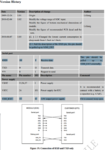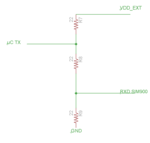Jacob Harris
Newbie level 6

I am looking to use the SIM900 module. I see that the module's power supply is from 3.2 V to 4.8 V. I will be running it with an ATMEGA328P microprocessor who's power supply range is from 1.8 V to 5 V. Naturally I would like to choose a power supply between 3.2 V to 4.8 V and simply use one power supply.
If this works that would be simplest. The question comes in when I see that the SIM900's RXD port needs to be pulled up to VDD_EXT externally. Which is at 2.8 Volts. Does that mean that serial communication can only work at 2.8 volts and that I cannot use a serial communication at 3.2 to 4.8 volts? I would like to know before I send data through at 4 V and destroy the SIM900.
I have seen some level shifter schematics which sound like it would work but I would like to avoid that complexity if possible. If I had to use a level shifter that would mean that I would be using two different power supplies and that would not be optimum. See the attached.
Here is the SIM900 datasheet if needed. **broken link removed**
If this works that would be simplest. The question comes in when I see that the SIM900's RXD port needs to be pulled up to VDD_EXT externally. Which is at 2.8 Volts. Does that mean that serial communication can only work at 2.8 volts and that I cannot use a serial communication at 3.2 to 4.8 volts? I would like to know before I send data through at 4 V and destroy the SIM900.
I have seen some level shifter schematics which sound like it would work but I would like to avoid that complexity if possible. If I had to use a level shifter that would mean that I would be using two different power supplies and that would not be optimum. See the attached.
Here is the SIM900 datasheet if needed. **broken link removed**




